Deep Sulcus Sign
Article information
Abstract
The deep sulcus sign is a radiolucent lateral sulcus where the chest wall meets the diaphragm. In a supine film, it may be the only indication of a pneumothorax because air collects anteriorly and basally within the nondependent portions of the pleural space, as opposed to the apex when the patient is upright. The costophrenic angle is abnormally deepened when the pleural air collects laterally, producing the deep sulcus sign. We present a brief image of a trauma showing the deep sulcus sign indicating a pneumothorax.
CASE
A 56-year-old male pedestrian was brought to the emergency department after a high-speed road-traffic accident. He had transient hypotension and tachycardia, which improved after the administration of intravenous fluids. The physical examination revealed multiple orthopedic injuries in addition to trauma to the right chest, pelvis, and head. He underwent prompt intubation and sedation. Chest radiography with the patient in the supine position showed a deep sulcus sign (Fig. 1.), which was highly suggestive of a pneumothorax. Chest computed tomography confirmed a pneumothorax (Fig. 2.).
DISCUSSION
In the supine position, air in the pleural space distributes anteriorly and basally at nondependent portions and causes deepening of the lateral costophrenic angle, producing the deep sulcus sign [1-3]. The deep sulcus sign is an important clue for diagnosing pneumothorax.
Notes
CONFLICT OF INTEREST
No potential conflict of interest relevant to this article was reported.

